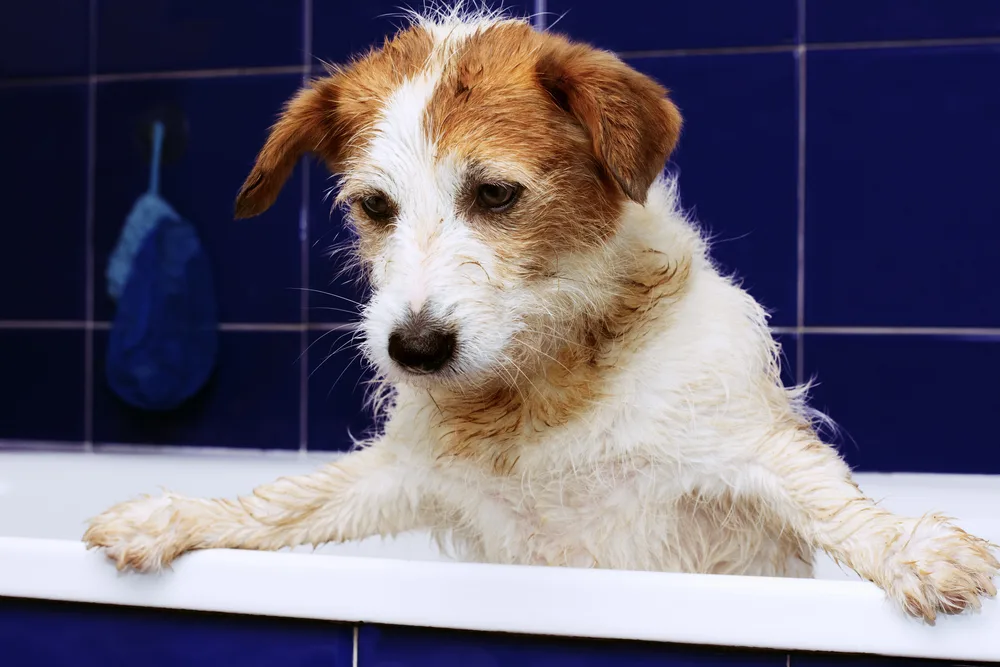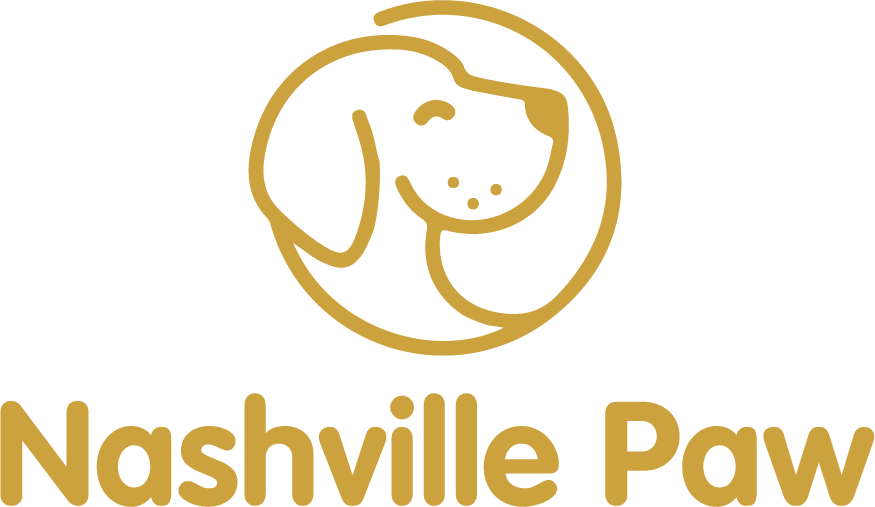Having a dog is more than just puppy kisses and cuddles. Dogs can get smelly without the proper grooming routine!
Things would be much simpler if dogs enjoyed bathtime. However, bathing can be stressful and confusing for your furry friend. The key is finding ways to improve the experience for you and your pup.
How do you make your dog’s baths easier?
With the right tools and techniques, bathtime will be a breeze. The types of nozzles, leashes, and shampoos you use will make a huge difference. Teaching your pooch to enjoy grooming through training also eases some burdens.
Dirty dogs stink up the house and create a real mess. If you’re struggling to keep up, don’t worry- we’ll teach you tricks to make your dog’s baths easier.
5 Ways to Make Your Dog’s Baths Easier
When you own a dog, grooming isn’t optional. This is especially true if you have long-haired dogs with high-maintenance coats.
However, cutting and brushing hair is only part of the job. Dogs need regular washes just like humans do!
Even short-coated dogs need baths. The number of times you bathe your dog will depend on its breed, skin condition, coat quality, and temperament.
As a grooming assistant, I saw dogs in various conditions. Many were frequently undergroomed due to behavior and a lack of owner education.

Here’s a chart to help create a unique bathing schedule for your special pet!
| Hair length/ dog breed | Bath frequency |
| Hairless- Chinese Crested, Xoloitzcuintli, etc | Once a week |
| Short hair- Chihuahua, Jack Russle, ect | Once every two to three months |
| Medium hair- Yorkie, Bichon Frise, Poodle, ect | Once a month |
| Double coats- Huskies, Chow Chow, etc | Once every three months |
Of course, these timetables may differ depending on your dog’s activity level and health. For example, you might bathe your short-haired dog weekly to treat a skin condition.
Baths can seem intimidating if your dog hates them. Instead of engaging in a wrestling match every bath night, use these techniques to make things easier.
Detangle First
Do you brush your hair before getting the shower? If so, why wouldn’t you do the same for your pup?
Detangling their coat is essential for a few reasons:
1. Knots block hair from soap and water, leaving your dog dirty.
2. Tangles get tighter in water, making them more difficult to brush.
3. Washing and detangling matted hair is painful and can cause skin irritation and injuries.
Before putting your dog in the bath, brush through their coat. Short-haired dogs only need rubber combs with short bristles to clear away any knots.
If your dog has medium or long hair, use a wide-tooth comb. Ensure you can brush through without any resistance before introducing soap and water.
Use the Right Soap
A good bath requires particular kinds of canine soaps and shampoos. After all, you wouldn’t wash your hair with hand soap, would you?
Using the right kind of soap is essential for a good bath experience. This is especially true if your dog is prone to irritation.
Many vets treat dogs’ allergies with special shampoos like chlorhexidine or ketoconazole. These ingredients kill bacteria and yeast that cause itchiness and inflammation.
If your dog stinks after a bath, consider talking to your veterinarian about medicated shampoo. Sometimes, yeast and other infection may leave a lingering odor that doesn’t wash away.
Never use human-grade soap on your dog. Our ingredients are too harsh and will strip your pup of the natural oils protecting their skin and fur.
Use a Detachable Nozzle
Bathing a dog in your tub is uncomfortable for everyone. Hunching over to pour water on your pup with your hands or a cup isn’t very efficient, either.
Dog baths shouldn’t be a workout. Instead, invest in a detachable nozzle to get every nook and cranny without straining yourself.
Detachable nozzles hook up to tub faucets and shower heads. They make it easy to direct a steady flow of clean water without flooding your bathroom.
Use your nozzle to rinse hard-to-reach areas like under the chin, belly, and armpits. You’ll never have to spend another bath night crouched over your tub!
Use Safe Restraints
Wiggling dogs and slippery bathrooms aren’t a good mix. It’s hard to bathe your pup when they’re trying to escape the tub every 10 seconds!
Moving your dog around a wet bathroom is dangerous for you and your pet. You can avoid slipping hazards by learning how to use safety restraints.
Slip knots work well to secure your dog without putting them in harm’s way. You can quickly detach your dog in an emergency by tying a slip-knotted leash to your faucet or soap holder.
Some people prefer to use makeshift harnesses. Watch this video to learn how to make a safe grooming leash at home!
Never leave your dog unattended while tied down in the bathroom. Restraints shouldn’t ultimately hinder movement; they should help keep your dog in the tub when they try to make a break for it!
Reward Good Behavior
Many owners avoid bath time because of their dog’s behavior. That’s why training your dog with rewards is so essential!
Start young with quick baths and grooming sessions. Familiarize your puppy with brushes, blow dryers, and nail clippers early so they know what to expect.
Resist the urge to yell when your dog misbehaves in the tub. Ignore whining and excessive movement; reacting to bad behavior in any way looks like a reward to most dogs.
Instead, give praise, pets, and treats when your pup is doing well. Be specific about your praise; when your dog listens to a “sit” command, give a reward immediately to reinforce that behavior.
Dogs are a lot smarter than most people give them credit for. After a few consistent behavior and reinforcement sessions, your dog will sit through every bath!
5 Things You Shouldn’t Do While Bathing Your Dog

Making your dog’s baths easier isn’t just about doing the right things; it’s also about avoiding the wrong techniques.
Bathing your dog the wrong way is counterproductive. You also risk teaching bad behaviors and worsening skin conditions.
If you notice these actions in your bathtime routine, stop them immediately and replace them with one of our healthy habits.
Get Water in Their Ears
Canine ears are shaped differently than humans. Their deep, “L”-like structure makes it difficult to remove water.
Moisture and dark, warm environment is the perfect breeding ground for yeast and bacteria. Wet ears are some of the most common causes of dog ear infections; unsuspecting owners often do it to themselves without realizing it.
Never spray water directly into the ear canal. Instead, use a cotton ball with canine-safe ear cleaner to remove dirt and debris.
Place cotton balls in the opening of their ear canals to keep things dry during bathtime. Don’t stuff them too far down; you only need to block the entrance.
Leave Soap on Their Skin
If your dog keeps biting or scratching after their bath, it may still have soap on its skin. Always rinse your pup thoroughly after every shampoo to remove stubborn suds.
Lingering soap dries the skin and causes discomfort. Some shampoo ingredients may also cause inflammation if you don’t rinse them off at a specific time.
This is where a detachable nozzle comes in handy. It’s easy to miss spots when removing soap with a cup of water or your hands.
Rinse your dog two times MINIMUM after shampooing. Keep rinsing until the water in your tup runs clean and bubble-free.
Bathe Without Prepping
A successful bath time starts with proper preparation. Baths go much quicker and smoother when you have everything your need close by.
Set up your bath station before you put your dog in the tub. Your grooming supply list might look like this:
- Shampoo
- Conditioner
- Rubber brush
- Cotton balls
- Treats
- Comb
Prep work also includes getting your dog ready for their wash. Brush their hair, clean their ears, and clip their nails first; this way, you don’t have to struggle with a wet dog afterward.
Wash Hair Down the Drain
It’s no secret that dogs lose a lot of hair in the tub. All of that fur goes down your drain, clogging your plumbing system.
If your dog sheds a lot, take protective measures to keep hair from falling into your drain. Dog-hair filters for tubs catch fur and allow for quick and easy disposal.
Steel wool works just as well if your tub doesn’t accommodate one of these filters. Place a ball of material at the top of your drain to block hair from entering your pipes.
Push Them Too Far
Like most things, bathtime comes with a learning curve. Owners must give their dogs time and space to feel comfortable around water and other grooming environments.
Know when to call it quits. Cut the bath short if your dog is about to hurt you or themselves trying to escape the tub.
Did you know that it’s possible to over-bathe your dog? Too many showers will dry their skin and leave their coats brittle.
Stick to our earlier chart for the best bath schedule for your breed. As always, consult with a professional groomer or veterinarian if you feel your pet needs special treatment.
FAQs
Should I wash my dog every time he gets dirty?
Yes. Active dogs attract dirt and debris that can cling to their fur. If your dog likes to swim, hike, or roll around in the mud, give them a quick rinse at a minimum.
How often should you wash your dog?
Bath frequency depends on hair length, texture, skin condition, and temperament. On average, short-haired dogs should have a bath every few months. Long-haired dogs should bathe at least once a month.
How often should you wash your dog’s stuff?
Wash bedding, toys, and accessories at least once weekly to remove smelly odors and grime. Your dog’s stuff might be contributing to its stink and general messiness.
Bottom Line
If your dog’s bathtime feels like preparing for war, you’re doing something wrong. Don’t be afraid to use these tips and tricks to make your grooming routine easier for everyone.

